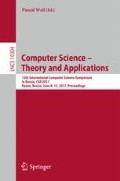Abstract
We show that there exists a binary PSpace-complete language \({\mathcal {L}}\) such that its unary coded version \({\mathcal {L}}'\) is in \({\textsc {ASpace}}^{\mathrm {dm}}(\log \log n)\), i.e., \({\mathcal {L}}'\) is accepted by an alternating Turing machine using an initially delimited worktape of size \(\log \log n\). As a consequence, the standard translation between unary languages accepted with \(\log \log n\) space and binary languages accepted with \(\log n\) space works for alternating machines if and only if \({\textsc {P}}= {\textsc {PSpace}}\).
In general, if a binary language \({\mathcal {L}}\) is in \({\textsc {DTimeSpace}}(2^{n}\!\cdot \!n^{\scriptscriptstyle O(1)},n^{\scriptscriptstyle O(1)})\), i.e., if \({\mathcal {L}}\) is accepted by a deterministic Turing machine in \(2^{n}\!\cdot \!n^{\scriptscriptstyle O(1)}\) time and, simultaneously, in \(n^{\scriptscriptstyle O(1)}\) space, then its unary coded version \({\mathcal {L}}'\) is in \({\textsc {ASpace}}^{\mathrm {dm}}(\log \log n)\). In turn, if a unary \({\mathcal {L}}'\) is in \({\textsc {ASpace}}^{\mathrm {dm}}(\log \log n)\), then its binary coded version \({\mathcal {L}}\) is in \({\textsc {DTime}}(2^{n}\!\cdot \!n^{\scriptscriptstyle O(1)})\cap {\textsc {DSpace}}(n^{\scriptscriptstyle O(1)})\), and also in \({\textsc {NTimeSpace}}(2^{n}\!\cdot \!n^{\scriptscriptstyle O(1)},n^{\scriptscriptstyle O(1)})\).
This unexpected power of sublogarithmic space follows from the fact that, with a worktape of size \(\log \log n\) on a unary input \(1^{n}\!\), an alternating machine can simulate a stack with \(\log n\) bits, representing the contents of the stack by its input head position. The standard push/pop operations are implemented by moving the head along the input.
V. Geffert—Supported by the Slovak grant contracts VEGA 1/0142/15 and APVV-15-0091.
Access this chapter
Tax calculation will be finalised at checkout
Purchases are for personal use only
Notes
- 1.
Throughout the paper, we denote the length of a binary input by n, while the length of a unary input by N. This reflects the fact that \(n<N\).
- 2.
\({\textsc {X}}{\textsc {Space}}(s(n))={\textsc {X}}{\textsc {Space}}^{\mathrm {dm}}(s(n))\), if s(n) is fully space constructible. The notation “dm” derives from “Demon” Turing Machines [4].
- 3.
This ensures that the same number cannot be represented by two different binary strings, using a different number of leading zeros.
- 4.
This is based on the following facts. First, it is quite trivial to see that the machine can compute \(m_i= (N\!+\!1)\bmod p_i\) for any given prime \(p_i\le O(\log N)\), by counting modulo \(p_i\) while traversing across the unary input tape with \(\vdash \!\!1^{\scriptscriptstyle {N}}\!\!\dashv \). Thus, the machine has a read-only access to \((m_1,m_2,m_3,\ldots )\), the first \(O(\log N{/}\log \log N)\) remainders in the Chinese Residual Representation of \(N\!+\!1\). With access to these remainders, the \(\ell \)-th bit in the binary representation of \(N\!+\!1\) can be computed by using \(O(\log \log N)\) worktape space. This was shown in [6], building on ideas presented in [5, 7]. (See also [1, Theorem 4.5]. Some related topics and other applications can be found in [2, 16]).
References
Allender, E.: The division breakthroughs. Bull. Eur. Assoc. Theoret. Comput. Sci. 74, 61–77 (2001)
Allender, E., Mix Barrington, D., Hesse, W.: Uniform circuits for division: consequences and problems. In: Proceedings IEEE Conference Computational Complexity, pp. 150–159 (2001)
Chandra, A., Kozen, D., Stockmeyer, L.: Alternation. J. Assoc. Comput. Mach. 28, 114–133 (1981)
Chang, R., Hartmanis, J., Ranjan, D.: Space bounded computations: review and new separation results. Theoret. Comput. Sci. 80, 289–302 (1991)
Chiu, A.: Complexity of parallel arithmetic using the Chinese remainder representation. Master’s thesis, Univ. Wisconsin-Milwaukee (1995). (G. Davida, supervisor)
Chiu, A., Davida, G., Litow, B.: Division in logspace-uniform \(NC^1\). RAIRO Inform. Théor. Appl. 35, 259–275 (2001)
Dietz, P., Macarie, I., Seiferas, J.: Bits and relative order from residues, space efficiently. Inform. Process. Lett. 50, 123–127 (1994)
Emde Boas, P.: Machine models and simulations. In: Leeuwen, J. (ed.) Handbook of Theoretical Computer Science. Elsevier Science (1989)
Geffert, V.: Nondeterministic computations in sublogarithmic space and space constructibility. SIAM J. Comput. 20, 484–498 (1991)
Geffert, V.: Bridging across the \(\log (n)\) space frontier. Inform. Comput. 142, 127–158 (1998)
Geffert, V.: Alternating demon space is closed under complement and other simulations for sublogarithmic space. In: Brlek, S., Reutenauer, C. (eds.) DLT 2016. LNCS, vol. 9840, pp. 190–202. Springer, Heidelberg (2016). doi:10.1007/978-3-662-53132-7_16
Geffert, V., Pardubska, D.: Unary coded NP-complete languages in ASPACE(log log n). Internat. J. Found. Comput. Sci. 24, 1167–1182 (2013)
Hartmanis, J., Immerman, N., Sewelson, W.: Sparse sets in NP–P: EXPTIME versus NEXPTIME. Inform. Control 65, 158–181 (1985)
Hopcroft, J., Motwani, R., Ullman, J.: Introduction to Automata Theory, Languages, and Computation. Addison-Wesley, Reading (2001)
Ladner, B., Lipton, R., Stockmeyer, L.: Alternating pushdown and stack automata. SIAM J. Comput. 13, 135–155 (1984)
Macarie, I.I.: Space-efficient deterministic simulation of probabilistic automata. In: Enjalbert, P., Mayr, E.W., Wagner, K.W. (eds.) STACS 1994. LNCS, vol. 775, pp. 109–122. Springer, Heidelberg (1994). doi:10.1007/3-540-57785-8_135
Meyer, A., Stockmeyer, L.: Word problems requiring exponential time. In: Proceeding of ACM Symposium Theory of Computation, pp. 1–9 (1973)
Savitch, W.: Relationships between nondeterministic and deterministic tape complexities. J. Comput. System Sci. 4, 177–192 (1970)
Szepietowski, A.: Turing Machines with Sublogarithmic Space. LNCS, vol. 843. Springer, Heidelberg (1994)
Acknowledgment
The author thanks the reviewers for their suggestions, especially for sending a summary of PC discussions which has stimulated future work in this area.
Author information
Authors and Affiliations
Corresponding author
Editor information
Editors and Affiliations
Rights and permissions
Copyright information
© 2017 Springer International Publishing AG
About this paper
Cite this paper
Geffert, V. (2017). Unary Coded PSPACE-Complete Languages in ASPACE(loglog n). In: Weil, P. (eds) Computer Science – Theory and Applications. CSR 2017. Lecture Notes in Computer Science(), vol 10304. Springer, Cham. https://doi.org/10.1007/978-3-319-58747-9_14
Download citation
DOI: https://doi.org/10.1007/978-3-319-58747-9_14
Published:
Publisher Name: Springer, Cham
Print ISBN: 978-3-319-58746-2
Online ISBN: 978-3-319-58747-9
eBook Packages: Computer ScienceComputer Science (R0)

